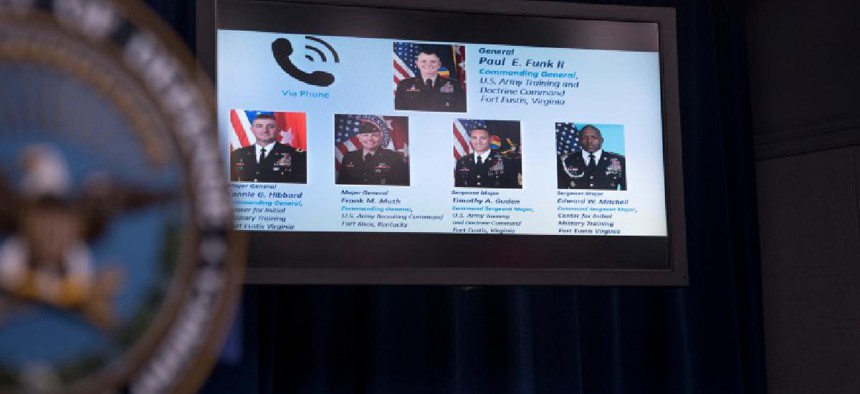Army accelerates virtualization of training, recruitment

Army training and recruiting leaders said the service has been gradually digitizing recruiting and training, but has now shifted online amid the COVID-19 outbreak.

The Army has moved its recruiting efforts completely online to support social distancing efforts recommended to stop the spread of the COVID-19 pandemic.
"We have been positioning ourselves in the world of the digital market for about 20 months," Maj. Gen. Frank Muth told reporters at an April 6 briefing. "So we made the call very early to transition from being physically in the recruiting stations to going 100% virtual. We made the call on the 15th of March."
"Minor stumbling blocks," Muth said, include getting the authority to process applicants via video teleconferencing apps. Now, recruiters can watch potential new recruits sign documents to verify their swearing in.
The Army has also suspended shipping new recruits to basic training starting April 6. Gen. Paul Funk II, the commanding general for Training and Doctrine Command, said the move does not affect the 54,000 soldiers already in Army training centers.
Funk said the pause, set to last two weeks, wouldn’t necessarily impact readiness because April and May typically have the lowest volume of recruits to ship out for training. Only 219 recruits were expected to ship by April 19, he said.
Additionally, the 10-week basic training has been altered, aggregating the academic class work to the first two weeks to maintain social distancing and controlled monitoring. Recruits still do physical training in the morning. Once they present no symptoms and test negative after the two weeks, they move to the eight-week collective training team building.
"There will be very few areas where we would have to use face coverings as a routine," Funk said. DOD issued guidance April 6 directing personnel to wear face coverings on DOD installations, facilities, and property.
Officials said they are directing classes be executed outdoors if possible, and when indoors, maintain the six-feet between instructors and trainees. Face masks are used when that isn’t possible.
Those who present symptoms are separated and monitored. Funk said there were about 102 total cases of COVID-19 out of 54,000 on the training base. So far 12 of those recruits who have become ill with COVID-19 have recovered.
"Social distancing has caused us to actually re-look at every bit of our capacity to be able to bring in as many people as we can," Funk said, who mentioned that maintaining the bubbles was an added strain. "Right now it's not impacting readiness...it's really about getting the transportation in place to move them, which we've been rehearsing for a number of weeks now."
NEXT STORY: Acting Navy secretary resigns



